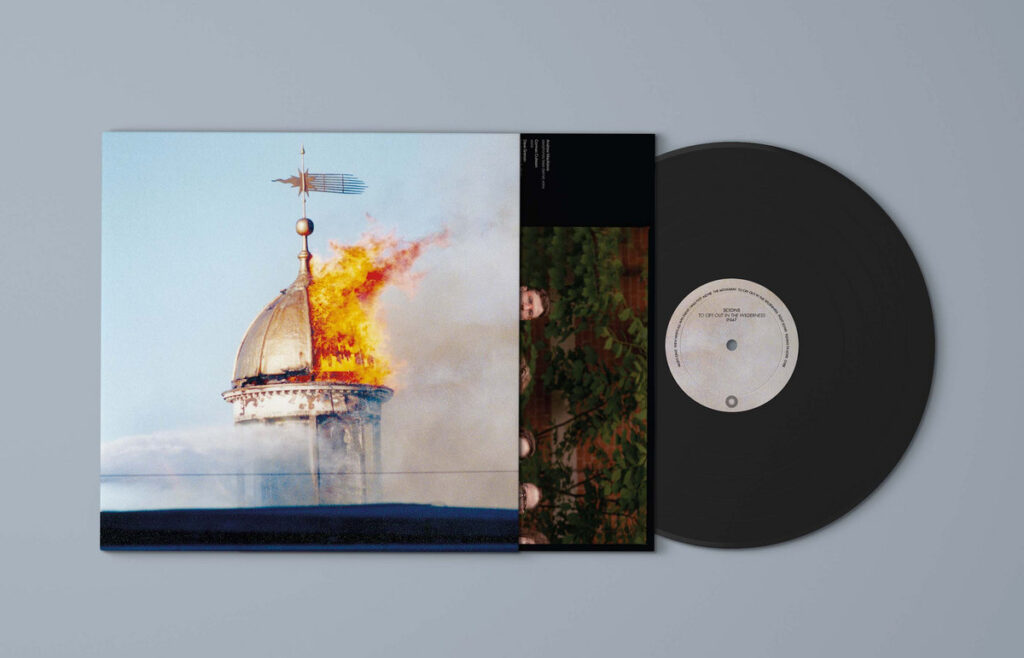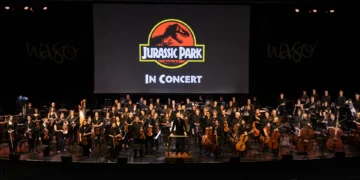Scions are pretty much the definition of everything we love here at Unruly Folk. Their genre-bending sound, mixing folk, doom, jazz, and whatever else strikes their fancy, doesn’t fit into any neat category, and that’s exactly the way they like it. We had a chat with Michael Cloud Duguay (MCD) and Cormac Culkeen about their creative process, why queerness and collaboration are at the heart of it, their solar-powered recording sessions, and their upcoming album, To Cry Out In The Wilderness, which is out on November 8th. Here’s what they had to say.
First off, how does it feel to see Scions grow from an “ad-hoc ensemble” into this distinct entity?
CORMAC: Scions became a distinct entity through shared work. We came into our writing residency on Wolfe Island as separate ensembles collaborating on a new suite of work. By the time we were mid-way through the recording sessions in Halifax, I think we had all been changed by the work of writing and recording these pieces. Michael is persistent in his creative visions. He works hard on the necessary parts of ambitious art-making. He is also remarkably good at bringing people together. He brought this together.
MCD: My favourite part of any collaborative project is observing a cohesive form appear. There is always a moment in any successful creative process where you can finally see it; it makes sense; all the chipping away you have been doing starts to reveal the work. It’s magic every time. The Scions project has delivered these moments again and again as it continues to mutate. Scions were only ad-hoc for a moment; something felt distinct from the first moment we joined each other in song. It continues to grow, revealing new distinctions. I had a very clear vision the moment I conceived this project and it has felt deeply rewarding to guide it along and watch it grow.
How would you describe your sound to someone totally new to it?
MCD: Chamber doom.
CORMAC: Scions’ sound is elemental, intimate, and earthen. There are strains of folk music throughout. Noise, improvisation, jazz, pop, electronic, and heavy elements breach the surface like breathing whales. Maybe it is chamber music, but for what chamber? Scions sounds like chamber music composed for a ruin, open to the sky.
There’s an almost mystical feeling that runs through To Cry Out In The Wilderness. Can you tell us more about how spirituality plays into your music and your personal lives?
CORMAC: I don’t know any better worship than singing. I don’t know a better way to pray or a better way to lament. Making music is the only way I’ve ever known how to rebuke cynicism. We can resist the temptation to be cool or aloof, and instead, we can quietly tell the truth: “I care a lot. I care a LOT.” Composing with Scions felt like a practice of coming together and laying down our little personalities and agendas in service or something better, which we didn’t know the shape of yet. The willingness of the members of Scions to engage in that generative work together was a gift.
MCD: For me, music is spirituality, and spirituality is music; they are the same thing. I don’t subscribe to any specific religious practice, but a spiritual practice, a connection to a power greater than myself, saved my life, and that connection was forged through music.
Community and collaboration are huge parts of your work—from the 15 guest performers on the album to the fact that the band itself is this amazing cross-pollination of different projects. How do you think being part of such a creative network has shaped Scions?
MCD: Each of us participates in dozens of creative projects, and we have radically different creative backgrounds and lived experience; I think that allowed us to begin our project outside of the confines of genre convention and to develop a distinct sound in improvisation first and then through a collaborative composition process. So, musically, arriving through all these different channels in this vast creative network is sort of the conceptual foundation of the work. But it’s not genre-mashing just for the sake of it. I think something that we all share is that we are all easily spellbound by art – we all genuinely get very, very excited by listening to and performing music and are super curious about new and unknown forms of expression, so we are always motivating one another and sharing ideas. We managed cohesion through reverence for one another’s backgrounds, practices, and skills. Essential to the vision for this project was world-building – developing both a narrative and sonic universe that our work can inhabit. It’s exciting for the population of that world to grow – maybe it’s just an evolutionary survival instinct. Everything I have ever made has been rooted in this sort of collaboration. Homogeneity is the death of art.
This album was recorded entirely using solar energy. That’s extremely cool! How did that direct the recording process for you, and how do you see it as part of the album’s identity?
MCD: The solar element was made possible by our engineer Jake Nicoll, who designed and built The Scamper, a solar-powered mobile recording studio that we used as a control room. This is the second of three full-length albums that Jake and I have made with The Scamper, each of which includes performances by at least one other member of Scions. This setup offers a lot of advantages – first of all, anywhere we can haul it, we can record, which lends an air of adventure to everything we’ve done with it. Jake and I had to pick up the scamper about 250 km away from where we were recording before we began production, which included taking a ferry and driving through the night, so immediately the project was a thrill before we had even set up. Another advantage is that, when recording in these old buildings we are sourcing all of our power from the Scamper’s solar panels, avoiding the sounds of potentially dirty power. The only power we used at St. George’s was their lights. Writing and recording an album about a post-environmental-apocalypse earth was partially a creative exercise but also a political one. Working with solar power allows us to actually walk the walk we are advocating for in our work. Jake is a genius, and we love him.

The image of St. George’s Round Church (Halifax) burning on your album cover is striking, especially knowing the album was produced there. Can you tell us more about how this came to be? Given the building’s history of destruction and restoration, it beautifully aligns with the album’s concept!
CORMAC: I love the story of the reconstruction of Saint George’s Round Church because it is a story of resurrection and redemption. And the church is founded on the hope of redemption and the possibility of life after great loss. Finally, a church building is not the Church – it is the people that make the church. Humans in our culture are tempted into the idolatry of putting our hope in material things – but that makes a God out of something we made with our own hands – a desert people clinging to a golden calf. St. George’s Round Church was nearly destroyed by fire, and it was the people, their labour, and their love of one another and the Divine that resurrected it. Their persistence as a community after disaster gives us hope. The image of the burning church reminded us that all things will pass away.
MCD: I will never forget the moment that we discovered that image. We all knew about the fire, and there was a small historical exhibit in the back of the church that included photos from the day of the fire. They were really striking, and I thought out loud that it would be great to dig through archives to see if there were more. Our production manager, Rebecca Fairless (who also performed pipe organ on the record), quietly started looking and then shared the eventual album cover image with us. I’ve never been in the midst of 9 people unanimously agreeing on something so quickly. It was and is perfect, and it makes for a great visual representation of our sound and homage to the space we worked in. The church and its congregation love that we’ve used it.
You’ve got this incredible mix of instruments. Harp, cello, double bass, saxophone, and accordion all working together. How do you go about arranging an eclectic mix to create that signature Scions sound?
MCD: I put a lot of thought into arrangements for this record. I’m normally a bit of a totalist – I like to start with everything and then peel it away – but I took a different approach with To Cry Out In The Wilderness. Obviously, it is not a minimalist record, but I wanted to play with space and air. I was interested in how noise could be soft and how ambience could be harsh. I wanted for each instrument to exist like a distinct character in our sound world. We really just needed to create space for one another to breathe in, and most of our songs are very long – they’re an exercise in developing that space. I brought lots of friends in and tried to be really thoughtful about where they contributed. I knew from the onset that I wanted to include the metal element, but not everywhere, for example. Much of our signature sound can be credited to Dave Grenon, who performs live processing and effects in Scions, and how his contributions were employed in the mix. In addition to processing much of the individual instruments, Dave also effected room recordings of our performances which provided an incredible tool in the mixing process. Basically, the entire church was used as an instrument that could be activated to create that massive multi-dimensional sound. It could also be muted to great effect as well. We hadn’t planned on using those processed room recordings for much, but it totally shaped the sound.
Music has been a vital part of your recovery journey. What role does music play in healing for each of you, and how do you hope your work resonates with listeners who might be going through their own tough times?
MCD: I wouldn’t be alive if I hadn’t become sober. When I was deep in my use, I was separated from music for nearly a decade – there were multiple years at a time where I didn’t touch an instrument, or listen to music. When I first became sober, I thought that there was no way I would ever be able to play music professionally again, but one day at a time, with a ton of support, I’ve been able to piece together a creative practice and a life that offers me a safety and security I never thought was possible. Music itself is healing, but the community that a life in music offers is what has provided these things.
CORMAC: I wouldn’t be able to be making this music today if I was still in active addiction. I was always a musician, even when I was drinking, and I wanted to create things with other people, but I couldn’t trust myself for shit. I couldn’t be relied upon for basic things, like calling people back or even treating my bandmates fairly and kindly. I was gut sick and shaky and always afraid and deeply ashamed. I didn’t know there were people like me who could help me, but there were. I didn’t know I could quit using and still write music, but I learned how, from other musicians who’d done it. The music isn’t in the bottom of the bottle. The creative spark isn’t in a stolen bottle of pills. It’s in our very selves. We aren’t alone.
Queer posterity is a powerful theme in your work, too. I’d love to hear more about how these ideas impacted the creation of the album. What message do you hope resonates with queer listeners when they listen to it?
CORMAC: I hope Queer listeners know that we have gifts that the world needs RIGHT now. We don’t exist only for ourselves. We are a blessing to the universe. Queer people get so good at telling the truth because they have to, or they die inside. So, we become truth-tellers in our families and communities. Queer people are oppressed and ridiculed, so we are gifted with the possibility of empathy and solidarity with ALL oppressed people if we choose to accept a hard gift. I like that the world spins around saying, “This is the way it is, and there’s nothing you can do about it”, and queer existence just begs to differ. We can change things. We can make the rules. There is no “Oz the Great and Powerful”. There’s a man behind the green curtain. Drag him out.
How do your queer, trans, and non-binary identities influence your band dynamic as a whole?
CORMAC: We have a gay old time.
Okay, this is a super nerdy one. I’m sorry, but please indulge me. As a nine-member band, if you were to represent Scions as a single environmental ecosystem, what would it look like, and what natural element or phenomenon (like air, water, earth, fire, or even a specific animal or plant) would you each represent?
CORMAC: I would say we would be a complex system of moss, lichen and fungi in a cold, damp forest.
MCD: Scions is a swamp, and each of us is a curious little arthropod.
If you had a message to leave the world with, what would it be? And how do you want people to feel after they experience one of your shows or listen to To Cry Out In The Wilderness?
CORMAC: I want people to hear this, and be angry and hopeful and joyful enough to do what they can for their little life. I want them to really feel the perversity of the world as it is. It’s not right that things are as they are. We could all march and break every window on Wall Street, and it would not be an act of violence. Genocide is violence. The destruction of the planet is violence. Telling people that freedom is about shopping is fucking violence. Forcing us to participate in a terrible cycle of environmental destruction and degradation of human and animal life is violence. Tear the whole fucking thing down. We were made to care for each other, to create, to be in relationship, and to work. Fuck whatever knockoff dystopian YA plotline this is. Tear the whole thing down. I want them to leave a show and call their best friend to tell them they love them. Go visit their grandma in the nursing home. Go out and shyly introduce themselves to their neighbours. Get a bucket and pick up some sharps. I want them to look up from their phones and say fuck this fuck THIS, I am just an animal. I’m a fragile, precious, finite animal. My body is good.
Amber Scott of Only by Midnight asks: Do you have a motto or a guiding principle that helps you make decisions? What is it?
MCD: Go long. Nothing is true, and everything is permitted. Trust your gut. Ignore convention.























































